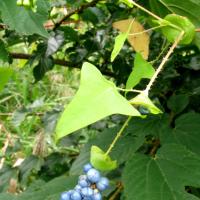Asiatic tearthumb
Persicaria perfoliata
Persicaria perfoliata, commonly known as mile-a-minute weed or devil's tail tearthumb, is an invasive plant species belonging to the Polygonaceae family. It is native to Asia and has become an aggressive weed in various parts of the world, including North America and Europe. Mile-a-minute weed is known for its rapid growth and ability to smother native vegetation. Here is a description of Persicaria perfoliata:
Appearance:
- Mile-a-minute weed is a climbing, herbaceous vine with slender stems that can grow at an astonishing rate, often several inches per day.
- The leaves are triangular or arrow-shaped, and they are arranged alternately along the stem.
- The stems are covered with small, recurved barbs or prickles, giving the plant its common name, "mile-a-minute."
Habitat:
- This invasive weed is commonly found in disturbed areas, along roadsides, in agricultural fields, and in natural areas.
- It prefers sunny to partially shaded locations and can tolerate a range of soil types.
Lifecycle:
- Mile-a-minute weed is an annual plant, meaning it completes its lifecycle within a single year.
- It reproduces by producing small, blue-black berries that are spread by birds and mammals.
Impact:
- Persicaria perfoliata is a highly invasive species that can quickly overtake natural habitats and agricultural fields.
- Its rapid growth and ability to form dense thickets can smother and outcompete native vegetation.
- The prickles on the stems can make it challenging to manage or remove.
Control:
- Management and control measures for mile-a-minute weed often include mechanical removal, herbicide application, and efforts to prevent the spread of its seeds.
- Early detection and rapid response are critical to managing infestations.
Mile-a-minute weed, or Persicaria perfoliata, is a significant invasive plant species that poses a threat to natural ecosystems and agricultural landscapes. Efforts are made to control its spread and minimize its impact on native vegetation and agricultural productivity.








